The Hottest Hit On The Planet:

“Get Right” by Jennifer Lopez
J.Lo was everywhere in the 2000s!
- You went to the club and what were they playing on the giant video screens? It was J.Lo!
- And who was the DJ spinning the J.Lo record/video file? It was J.Lo!
- And who was dancing on the bar to the J.Lo record played by DJ J.Lo? It’s J.Lo again!
- And who is serving drinks to the J.Lo dancing on the bar to the J.Lo record played by DJ J.Lo? It’s bar waitress J.Lo!
And who’s the – as IMDB describes them – “heavily made-up woman” consoling the other “heavily made-up woman” whilst applying their make up in the toilet?
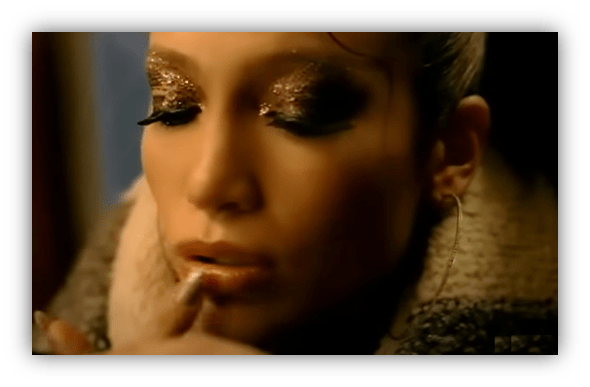
It’s two heavily made-up J.Los! Or possibly drag-Los?… I’m not entirely sure.
And who’s the celebrity at the bar, wearing sunglasses, trying – badly it must be said – to go incognito? It’s sunglasses-wearing-celebrity J.Lo! ie, quite possibly, the actual J.Lo!!!

And who was the nerdy girl in the corner getting way too excited, upon spotting celebrity-in-sunglasses possibly actual J.Lo J.Lo?
And then getting even more excited after bar waitress J.Lo serves her too many drinks? It’s uptight-office-worker-J.Lo!
That’s a lot of J-Lo! And in so many different roles! TAKE THAT, all the critics who said she couldn’t act! The video for “Get Right” might just be the best thing she ever did!
But despite being one of the most famous people in the world, J.Lo still understands the hassles of having to drag your little sister along to your DJ set, and having to hide her in the booth, because your mother has to work. Because – don’t be confused by the rocks that she got – J.Lo, aka Jenny From The Block, used to have a little, now she has a lot…
A lot of magazine covers that is:
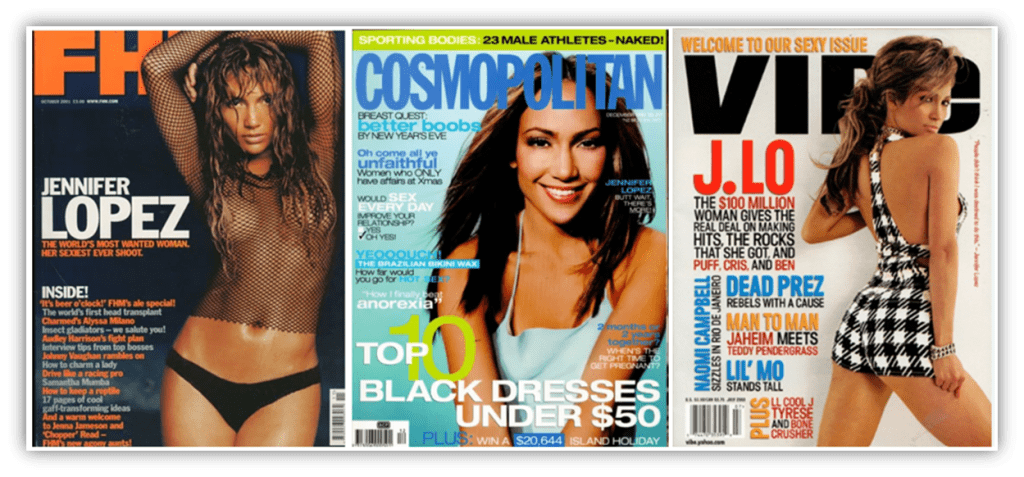
A lot of paparazzi following her, too. But no matter where she goes, she knows where she came from: The Bronx!
J.Lo – aka one half of Bennifer – spends a lot of the “Jenny From The Block” video – her hit from a couple of years earlier – being stalked by paparazzi whilst she’s having intimate moments with Ben Affleck, who seems to spend a lot of time playing her bum like a bongo. And who could really blame him?
J.Lo spent a lot of “Jenny From The Block” – her hit from a couple of years earlier – banging on about how she was real…
“I stayed grounded as the amounts roll in,” she insists.

“I’m real, I thought I told you (I’m real)
I’m really been on Oprah (I’m real)
That’s just me
Nothing phony, don’t hate on me
What you get is what you see.”
It’s deeply ironic then that rumours have followed J.Lo to this very day that almost all of the vocals you hear on “Jenny From The Block” are from her backing singers.
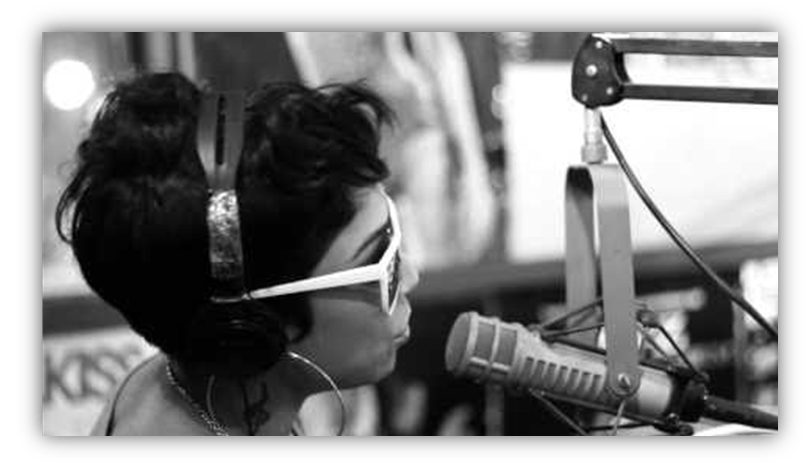
Specifically, Natasha Ramos.
The same could be said about most of J.Lo’s hits, most of which were sung by Ashanti or Christina Milian.

And for “Get Right”, Y’Anna Crawley, who, to be fair, got paid enough for it that she bought a diamond ring!
Being real was pretty much J.Los whole deal. When, at the 2000 Grammys David Duchovny told her that, ever since he was a kid he’d wanted to meet the “six million dollar woman”, she said “I’m not bionic… I’m real.” Maybe that’s where it all began? She’d also had an uber-hit with “I’m Real”, just in case you didn’t get the memo.
Being real was also the whole subtext to Maid In Manhattan.
Here’s Ralph Fiennes as Senate candidate Christopher Marshall describing Jennifer as hotel maid Marisa Ventura: “I’ll tell you who she isn’t. She isn’t like anyone I’ve ever met before. And she isn’t a phony.“
J-Lo was so dedicated to being real – except when she was singing – that, in 2004, she announced she was killing off the J.Lo persona because… IT WASN’T REAL!

“I’m not J.Lo, she’s not a real person. She was just a bit of fun that got really crazy. I’ve never been anyone but Jennifer.”
I don’t even know what’s real anymore! Wasn’t J.Lo just a nickname that she was given by “Now That We’ve Found Love” hit-maker and vaguely credible rapper Heavy D, who liked to call her Jenny Lo? Which then got further shortened because she was dating Sean Combs, who had his own way too many – and way too confusing – collection of nicknames?
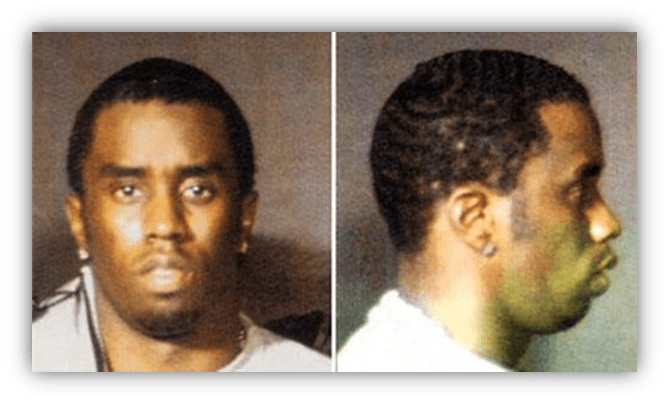
(Which would turn out to be the least worrying thing about him)
J.Lo’s career was in a weird place in the mid-00s. She was one of the most famous women in the world, one half of the most famous couple in the world, Bennifer – the first Hollywood supercouple portmanteau, beating Bragelina by four years! – a combination capable of selling a million magazines, but virtually zero movie tickets.
Bennifer had gotten together on “Gigli”, one of the worst movies of the 00s. It has a 2.6 rating on IMDB. An 18 on Metacritic. It won the Golden Raspberry for “Worst Picture.” Ben won “Worst Actor.” J.Lo herself won “Worst Actress.” Together they won “Worst Screen Couple.”
Hollywood supercouple portmanteaus weren’t J.Lo’s only celebrity innovation.

Glow by JLo was the first 21st century celebrity fragrance. If Glow by JLo never happened there would be a lot of empty shelf-space at your local department store or discount chemist.
So…
- J-Lo’s film career?… rubbish.
- Her love life? Um… eventful. She and Ben broke up in 2004, but then she married Marc Anthony a few months later.
- Her status as having the most famous bum in the world? Under threat from Kylie Minogue.
- Her just-standing-around-being-famous career? Couldn’t be better.
But you can’t just stand around being famous. You need to do something. You need to produce content for the fame machine. Even Paris Hilton needed to make “The Simple Life” and “1 Night In Paris”, the latter probably not intentionally.
It was time for J.Lo to make another album. Another banger.

A banger produced by Rich Harrison, aka the man behind Beyonce’s “Crazy In Love.”
A man who at that very moment was in the charts with Amerie’s “1 Thing”, one of the greatest and most joyous wonders in 00s R&B.
Even if a large chunk of the credit for that needs to go to the Meters’ sample, in much the same way as a large chunk of the credit for “Crazy In Love” needs to go to The Chi-Lites (both “Crazy In Love” and “1 Thing” are 10s.)
So, Rich had written and produced two hits based on two funky retro soul samples, and with “Get Right” he was trying to write another one. In the case of “Get Right” the sample was “Soul Power” by Maceo And The Mack’s, aka James Brown’s backing band recording under a different name.
But “Get Right” wasn’t initially supposed to go to J.Lo. It was initially supposed to go to Usher. Or at least, the beat was supposed to go to Usher, because the resulting track – “Ride” – is otherwise very much a different song.
Usher didn’t end up releasing “Ride.” But it still got out. It still found its way onto the Internet. It still got played in the clubs. Rich didn’t want that beat wasted on some leaked bootleg, not when said leaked bootleg was getting play.
And so, it was handed to J.Lo. Sometimes, once “Get Right” was released, DJs would play the two back-to-back, just to really annoy those of you who think that saxophone honk sounds like J.Lo is repeatedly stepping on a mouse.
Sadly, “Get Right” possesses neither the full-on “HISTORY IN THE MAKING!!!!” power-surge of “Crazy In Love” nor the breezy-flirtatiousness of “1 Thing.” It’s simply not that much of a song.

J.Lo wants to party, she wants you to party with her, but you’re just doing it wrong:
“You’re looking just a little too hard at me
Standing just a little too close to me
You’re saying not quite enough to me
You’re sipping just a little too slow for me”
“Get Right” is about a guy getting it wrong. Not unlike poor Rich Harrison.
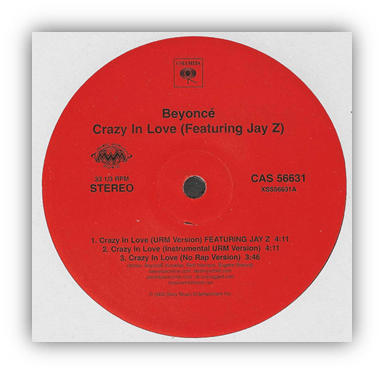
That’s okay. Not every record can be a “Crazy In Love” or a “1 Thing.”
I’m previously on the record for giving “Get Right” an 8. I must’ve gotten a little overexcited in the moment. This time I’ll get it right:
“Get Right” is a 6.
Meanwhile, in Rap Land:
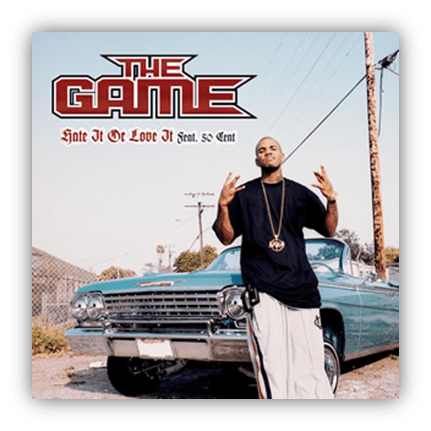
“Hate It Or Love It” (feat. 50 Cent) by The Game
Honestly, 50 Cent deserved more than just a “feat”, don’t you think? 50 himself obviously thought so. We’ll get to that later.
The Game, on the other hand, thought differently.

The Game thought he deserved all the props he got.
All the accolades, including the one that he gave himself: that he was “rap’s MVP.”Which, in case you’re not into sports, translates into Rap’s Most Valuable Player. Is that the same thing as being The Best Rapper Alive?He also informed us that he ain’t goin’ nowhere, so you can get to know him.
Which, as it turned out, was so optimistic it was practically deluded.
This of course begs the question: who was rap’s MVP/Best Rapper Alive in February 2005? The cusp of 2004 and 2005 feels too early for peak-Kanye, too late for peak-Jay-Z…
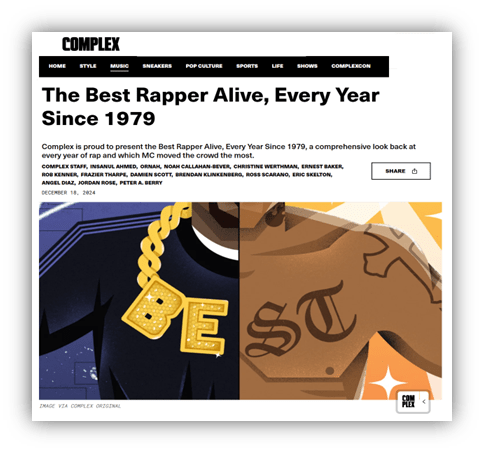
According to this list in Complex – a magazine that ought to know – it was T.I. in 2004, and Jeezy in 2005.
At least on paper, 50 Cent and The Game were a dream team. They had a lot in common.
Like 50, Game had been shot! Five times! Well, five bullets, one occasion. He’d ended up in a coma for a few days. According to rap-legend, when he woke, he asked his brother to buy him all the classic hip-hop albums so that he could learn from them.

Maybe he thought that getting shot was some sort of hip-hop qualification, and now he had a foot in the door.
Or maybe he simply realized he had to get out of the hood (not that being a famous rapper exactly makes you immune from being shot).
Like 50 Cent, Game seemed to mumble when he rapped, even though he didn’t have a bullet fragment in his tongue to excuse it.
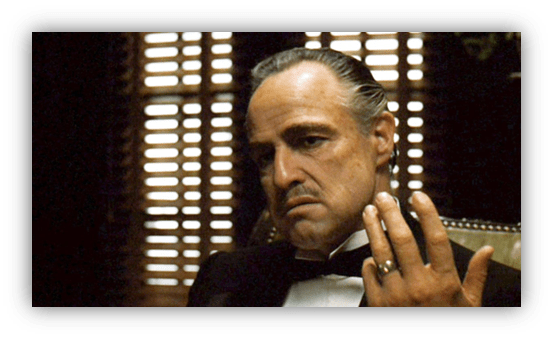
I get the feeling that, at least on the chorus to “Love It Or Hate It”, Game isn’t trying to be 50 Cent so much as Marlon Brando in The Godfather.
Like 50 Cent, Game was trained by Dr. Dre. Whether or not he was taken to a secret underground lair to be enrolled in a precisely calibrated science-based fitness regime, I’m not sure.

Although, like 50 Cent, he was incredibly buff.
Dr. Dre had decade that Game needed to join 50 Cent’s rap-posse G-Unit (short for Gorilla Unit apparently), a crew that was originally just 50 Cent and his childhood buddies but was gradually expanding to include other rappers who needed a bit of a marketing/street-cred bounce. Rappers such as Game.

As a member of G-Unit, Game earned the right to brag about how he hung out with 50 Cent a lot, and boy, on “Love It Or Hate It,” he does that a lot!
“Love It Or Hate It” is primarily a nostalgic hip-hop jam in which 50 and Game reminisce about their respective old skool childhoods over the top of an old Trammps sample that’s not “Disco Inferno.” There was more to The Trammps than “Disco Inferno, you know.
Weirdly enough, 50 Cent’s own hit single at the time was called “Disco Inferno:” The video for which features more twerking than you have ever seen in your entire life! Other than a single line “It’s hot, disco inferno” that 50 rhymes with “let’s go, you’re now rockin’ with a pro”, the two songs have nothing in common.
“Love It Or Hate It” is different from all the other nostalgic hip-hop jams of the period, in that 50 and Game mostly complain about how terrible that era was. “Love It Or Hate It” is also different from all the other 50 Cent jams, since he shows a soft and vulnerable side that he’d never shown before. The kind of soft and vulnerable side where he might begin a track by rapping about his mommy.
“Coming up I was confused, my mommy kissing a girl”
Listen, that lyric probably doesn’t read as being particularly enlightened, but by 50’s standards, it’s practically woke. And it’s still gangsta. 50’s mommy had been a part-time prostitute. She’d also sold drugs on the side.

She didn’t make much, but she made enough to buy young 50 a secondhand children’s dirt bike. She had one too, but grown-up size.
They’d ride around the streets together, side-by-side. But then 50 woke up one morning, and they’d stole his bike. This appears to have been the moment that 50 understood, he needed to get out of the hood. To “run away from this bitch and never come back if [he] could.”
Game is also rapping about his family:
Whenever I’m in the booth and I get exhausted, I think
What if Marie Baker got that abortion? I love you, ma
Not enough rap songs thank their mother for not aborting them. Fun family-related fact:
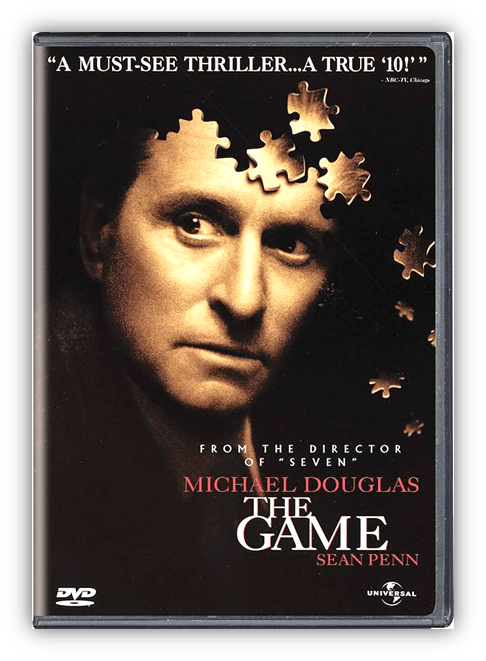
The Game was named The Game after the David Fincher movie “The Game”, one of his grandmother’s favourite movies. Not enough rappers name themselves after their grandmother’s favourite movies.
But mostly The Game raps about how he’s rap’s MVP and he ain’t going nowhere so you can get to know him. But Game did go nowhere. And the reason Game went nowhere is because 50 Cent was having a beef.
Maybe it was due to the cut-throat nature of the 00s rap game, or maybe it was because 50 Cent really enjoyed his rap beefs:

He’d already had one big beef with Ja Rule, and another with Jay-Z .
But on the cusp of 2004 and 2005, 50 Cent was engaged in three separate but simultaneous rap beefs. One with Fat Joe. Another with Nas. And yet another with Jadakiss. It must’ve been exhausting. No wonder 50 Cent always sounded so tired.
Game didn’t want to get involved. “I ain’t gonna turn on my friends” he said. “And Nas is one of my friends, and Jada’s really a homie … 50’s beef is 50’s beef.” The problem was, by not turning on his old friends, Game was turning on his new friends. Or at least his new coworkers. The ones who had given him a career.

Game didn’t seem to understand the rules of the game; that G-Unit was like NATO.
That a beef with one member of G-Unit is a beef with all the members of G-Unit. Game’s beef boycott was never going to go down well.
And by not going down well, I mean 50 Cent firing Game from G-Unit: in a radio interview with Hot 97, pointing out that “every record he’s selling is based on me being on his record with him.” Which is a terribly conceited thing to say of course, but also 100% correct.
Game and his own posse were hanging just down the road when this went down, so they stormed into Hot 97 studios – whilst 50 Cent was still on air – resulting in a stand-off between Game’s posse and 50’s posse, and one of 50’s posse shooting one of Game’s posse in the leg.
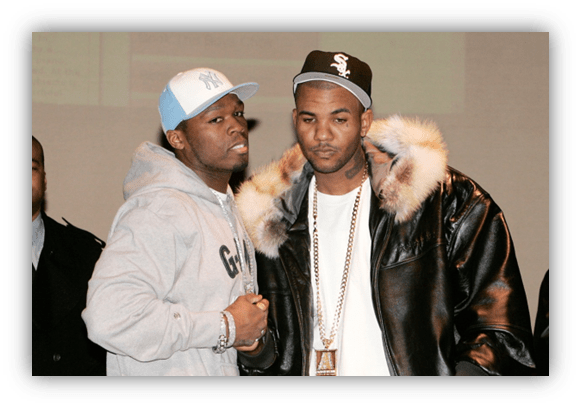
There are some who believe that the shoot-out was a publicity stunt. 50’s album was titled “The Massacre” after all. But probably not.
Without 50 Cent rapping beside him, in his car or in his private plane, nobody seemed all that interested in anymore in The Game, thereby providing “Love It Or Hate It” with yet another hazy layer of nostalgia: I’m sure Game sometimes puts the CD on, sighs, and remembers the time when he and 50 were two thugs united against the world. Two homies shining until their hearts stopped.
“Love It Or Hate It” is a 10.
Meanwhile, in Scandinavian Land:

“Heartbeat” by Annie

and “Be Mine” by Robyn

(with a slight detour to “Heartbeats” by The Knife)
Scandinavian-pop in the 00s wasn’t all Max Martin, you know. By the middle of the decade, if you wanted pop to make you bop, even whilst it was making you cry, there was only one chilly corner of the world towards which you needed to turn.
Whilst Max and his cronies were busy creating the kind of pop music that made you suspect the world was being controlled by some shady corporate oligopoly, the same corner of the world was leading the pop resistance:

Creating pop that sounded as though it came from a friendly neighborhood Mom & Pop store instead of a faceless, soulless, global corporation.
Pop music built by hand, not by robots. Socially democratic pop with a generous welfare safety net. A resistance led by two pop stars so friendly that they let you call them by their first names: Annie and Robyn. Both of whom had a lot of sadness in their lives, which often came out in their music.
Sadness probably would have come out in their music anyway. There were Scandinavian, after all.

And Scandinavia is the home of melancholia, a reputation the region holds despite constantly being at the top of United Nations World Happiness lists.
It’s that recipe for happy tears that Annie so perfectly captured on her hipster-blog hit – ie., Pitchfork crowned it the Best Song Of 2004 – “Heartbeat.”
Whilst the evil forces of popular song made music for half-naked sweaty bodies crammed into big city mega-clubs, the life Annie describes in “Heartbeat” takes place some small neighborhood bar where she is hanging out with her friends. It begins:
“There was a time
Everybody was around and I was dancing with you
We all went down to the party Friday night
And had a drink there or two.”
It was the kind of song that could only come from a town like Bergen:

A town which, despite being Norway’s second largest city, has managed to stay quaint. A town whose waterfront is referred to as “the city fjord.”
It was there that Annie met and fell in love with Tore Kroknes and they made a record together, sampling Madonna’s debut single “Everybody”, and turning it into “The Greatest Hit.” It wasn’t quite the greatest hit, but it was still pretty wonderful (“Everybody” is an 8.)
But Tore had a degenerative heart condition, and he died in 2001, at the age of 23. Annie spiralled into depression, didn’t leave the house, didn’t go clubbing, and became a cat lady:
“My cat is named Joey—for Joey McIntyre (from New Kids On The Block) but also for Joey Ramone. He’s a half-pop and half-rock cat. I have very eclectic tastes.”

Eventually she did go out again – after all, it’s what Tore would have wanted
But that sadness never really left her, even when singing grammatically confusing pop nonsense like “Chewing Gum.” Grammatically confusing because I’ve never been able to figure out whether the “chewing” referred to is a verb, or a noun (“Chewing Gum” is a 9.)
“Heartbeat” was originally titled “My Heart Beat.” At some point though they decided to drop the “My.” Just “Heartbeat.” It was cleaner.
“Heartbeat” was produced by – check the spelling because I always get it wrong – Röyksopp – it’s Norwegian for “smoke mushroom” – who had been spending the last couple of years doing their part in making Norway the epicentre of sad sounding dance music (pretty much everything on their debut album “Melody A.M.” is at least an 8… here’s “Poor Leno”, a 9:)
Now, “Heartbeat” should not be mistaken for another Scandinavian cult-hit, “Heartbeats” by The Knife:
A song which was a couple of years old at this point, although it had just been re-released, to give it another chance after being was completely ignored the first time around. It took a long time for “Heartbeats” to become enough of a modern day classic that Jose Gonzales would give it the completely unnecessary folksy singer song writer treatment… (“Heartbeats” is a 10, The Knife “Heartbeats” that is… rate the coffee-shop version? No way, Jose!)
It was about this point that washed-up 90s pop starlet Robyn discovered The Knife whilst flicking through a record store… and it would change her entire approach. It would change the way she thought about… EVERYTHING! The Knife have that sort of effect on people.
It wasn’t just the intense melancholy of their take on electro-pop:

It was the fact that they had their own record label.
A gutsy move, although also one that ensured that it took years for their songs to become hits. She was also impressed that they were brother and sister, but that’s not so relevant to our story.
Since the Swedish electro-pop scene was rather small, The Knife helped Robyn out on “Who’s That Girl?”, definitely the best song titled “Who’s That Girl?” ever written (it’s an 8), and a question that is definitely relevant to our story.
For a large part of Robyn’s career up to this point had been spent trying to clear up the confusion that came with having a hit with a song called “Show Me Love” (it’s a 7) during the same decade –as Robin S had a hit with a song called “Show Me Love” (it’s a 9). Two Rob(y/i)ns, two “Show Me Love”s, one decade… what were the chances?… Nobody knew what was going on! It was anarchy!!
Now, Robyn’s “Show Me Love” had been written and produced with Max Martin, so for a minute there it looked as though Robyn was going to be the Swedish Britney. But then she had an abortion in 1998 and wrote an album about it – “My Truth”, probably not where that phrase came from – or at least a couple of songs, thereby ensuring that it wouldn’t be released in the U.S. Or anywhere else outside of Sweden for that matter.
Robyn had to start all over again: Reinventing herself as a tough-no-nonsense tomboy with a soft creamy interior, coming up with an instantly iconic and aggressively angular haircut, and form her own cutesy record label Konichiwa Records, of which, according to “Curriculum Vitae” – my pick for the best side-one, track-one in history, at least in terms of setting the scene for what was to follow – she is the founder and CEO.
What was to follow that introduction was “Konichiwa Bitches” in which Robyn further reinvents herself as a cartoon-super-hero. (“Konichiwa Bitches” is a 10.)
But that cartoon-super-hero-version of Robyn wouldn’t be the Robyn that sold. The Robyn records that would become hits would be those where her heart was shattered into little pieces.
There’s something about Robyn’s voice, even when she’s just talking normally – even when she’s berating you for eating in her jacuzzi – that makes her sound like a petulant toddler.

That makes her the perfect artist for Wiggles-rap like the above…
…but also to narrate the utter gut-punch of seeing you with your arm around wassername, who had on the scarf Robyn gave you, as you got down to tie her laces.
“Be Mine!” may be the most heartbroken sounding song ever to feature an exclamation mark. That exclamation mark may cause you to assume that the dude would be Robyn’s. He is not. He never was. He never will be.
By the end of the 00s, Robyn would be the Queen Of Pop for people who thought they were too cool for the Top 40. And the best was still to come.
“Heartbeat” is a 10. “Be Mine!” is a 9.
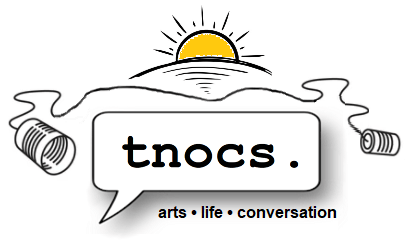
Let the author know that you liked their article with a “Green Thumb” Upvote!




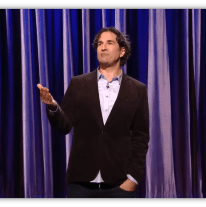
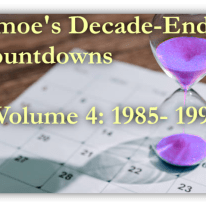
So there were obviously a whole bunch of bum references there. What with J.Lo and 50 Cent’s “Disco Inferno” video… but not a single bum reference in the Annie/Robyn section…
I feel that needs to be rectified.
https://www.youtube.com/watch?v=E_rjiPT-QH4
I have no memory of the J.Lo or Game/50 Cent tracks. I don’t feel like I missed out.
Whereas The Knife and Robyn get a big thumbs up. Robyn especially. One of my favourite singers of the last 20 years. A minor quibble, she could do with upping the workrate – 7 years and counting since the last album.
Be Mine! is a 9 but I agree the best was yet to come and with added heart shattering sadness, With Every Hertbeat is perfection.
I missed all of these songs but, like you say, I don’t think I missed out. I’m interested by The Knife and will probably give them a listen later, but every time I give Robyn a try, she goes in one ear and out the other.
Still an interesting read, DJPD, nice investigative reporting.
I like J.Lo as an actor. Her music? J.No.
Didn’t know any of the Scandinavian stuff. I was more about the indie rock at that point.
The Scandinavians >> 4,000,000 miles > everyone else in today’s column.